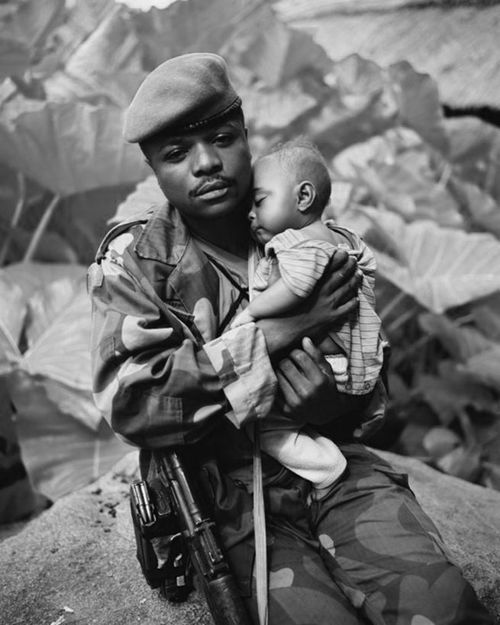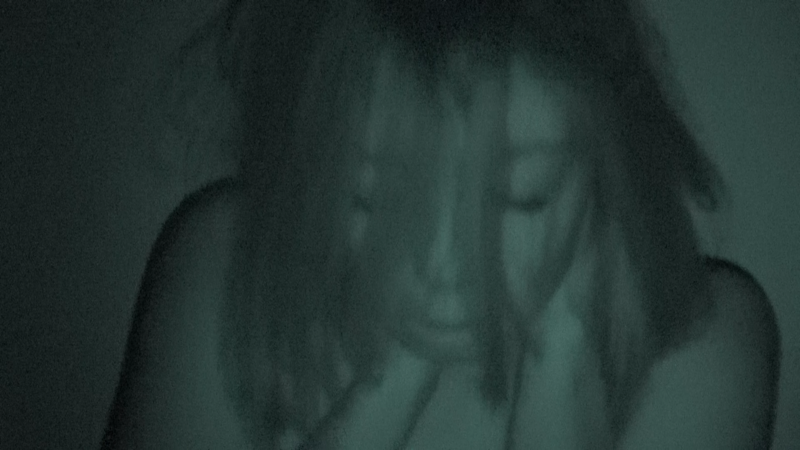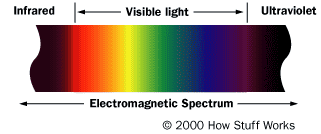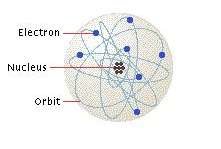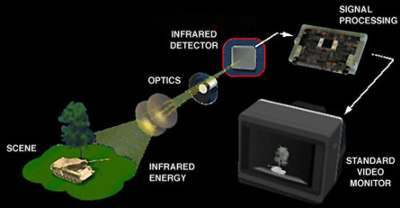Marieke / Field Report: Difference between revisions
No edit summary |
No edit summary |
||
| Line 281: | Line 281: | ||
[[File:Nightvision-thermal.jpg|500px|frameless]] | [[File:Nightvision-thermal.jpg|500px|frameless]] | ||
'''Types of Thermal Imaging Devices''' | |||
Most thermal-imaging devices scan at a rate of 30 times per second. They can sense temperatures ranging from -4 degrees Fahrenheit (-20 degrees Celsius) to 3,600 F (2,000 C), and can normally detect changes in temperature of about 0.4 F (0.2 C). | |||
There are two common types of thermal-imaging devices: | |||
* Un-cooled - This is the most common type of thermal-imaging device. The infrared-detector elements are contained in a unit that operates at room temperature. This type of system is completely quiet, activates immediately and has the battery built right in. | |||
* Cryogenically cooled - More expensive and more susceptible to damage from rugged use, these systems have the elements sealed inside a container that cools them below 32 F (zero C). The advantage of such a system is the incredible resolution and sensitivity that result from cooling the elements. Cryogenically-cooled systems can ''see'' a difference as small as 0.2 F (0.1 C) from more than 1,000 ft (300 m) away, which is enough to tell if a person is holding a gun at that distance. | |||
While thermal imaging is great for detecting people or working in near-absolute darkness, most night-vision equipment uses image-enhancement technology. | |||
Revision as of 13:25, 13 December 2018
Notes on progression so far:
I have recently identified a problem and a contradiction in my work: Using a method like infrared (scientific objective method) to portray the unconscious. But I do think that this struggle / potential impossibility could make an interesting research question. What does this unconscious mean to me?
The first thing that comes up are memories and experiences that make up the mind, which the brain organises. I am interested in this in a scientific sense but at the same time also from the perspective of empathy; it is a concern that is with me all the time.
I could call it the part of our existence that is not physical. In the past people would have used the word spiritual. This is also connected to atomistic philosophy which states the interconnectedness of people and things.
I keep contradicting myself in my research but I am okay with constructing sort of an thesis followed by an antithesis.
Primary emotions that we are not aware of mainly in relation to fear is also an important motivation for my interest in the unconscious.
Whether I am dissolving or destructing images or capturing them in infrared, there is an underlying theme of decay, vulnerability, exposure and destruction in relation to the process and the subject. When an image becomes actually red like in my digital infrared images, there is a fleshy way of exposing the environment, as if the skin has been exposed, (the image is the body). While experimenting directly with the image of a face or body means you do something to it, this makes the connection less static. Infrared is of course in its history closely tied to war, migration, security and violence. It is a way to detect the stranger and enemy.
Ironically I was at first-hand attracted to infrared because I felt it would bring me closer to the subject (people). Because I would be able to look at them in a different exposed state. When I did the infrared photography I could not even see my subject through the viewfinder because of the dark filter. This was the case with both the analogue and digital camera. So a lot of the documentation is connected to chance. This is a very different experience to the traditional approach of finding 'the enemy' with infrared techniques.
Artists like Francis Bacon and Richard Mosse are equally important to me even if they might seem quite different in their approach; both speak of violence and decay. During the Image Analysis people saw the underlying violence in my photo. This has happened before in the past with my work and I don’t always notice it myself.
The emotion of fear might be deeply engrained in my work and this might be why I am so attracted to infrared techniques. It is a feeling that is prominent, so people notice these motives of damage and fear. This can make the viewer uncomfortable and create a push-pull effect. They look away and look back again.
Because of my choice to work with infrared techniques I have to deal quite a lot with physics and science. Before I only considered the poetic parts of photography but I learned to appreciate this other part now.
Image Analysis, Richard Mosse in Black and White
- Black and White
- High contrast
- Eyes look in distance he's seen a lot
- Gun
- Military
- Maria with baby
- Leaves are like backdrop
- Pose so perfect composed
- Is he posing or did the photographer find them like this?
- Not sure if the background was manipulated into the picture
- Sad
- Baby is huge contrast to soldier
- Baby seems at peace with eyes closed
- Soldier is protecting
- They sit on a rock
- Nature setting
- I think the man is not old
- Defeat
- Why is he wearing his gun while holding a baby in a setting like this?
- Danger
- Small moment of rest
- The connection between soldier and baby is protective, moves me.
- Partially moves me because the soldier must have been through so much, what awaits the baby?
- Leaves seem so light, artificial
- Soldier is dark, baby is lighter (lighting)
- Sharp shadows
- Documentation
- He is a real soldier
- Stone where they sit on has composed angles
- Congo
- Contrast between real and posed
- Timeless
- Baby still naive soldier opposite
- Baby has light clothes like a blank canvas
- Wrinkles and texture in both of their clothes
- What has the soldier seen and experienced?
- Soldier doesn't seem to have been protected at all except with gun and army wear, but that is just a defense against violence and war never protected in the 1st place.
- Grief
- Leaves seem like a collage.
- Clear layers in picture because of backdrop
- He holds the baby gentle
- Man is covered in shadows, baby in light
- Gun is only thing with no soft organic shape
- Gun has hard texture
- Gun is the only thing with angled shapes and completely dark/black
Infrared Photography
- Infrared photography falls under the near infrared spectrum.
- Wavelengths are 700 nm to 900 nm.
Nanometer: Nanometers are used to measure the smallest things, usually those the size of an atom or molecule. This term is used in the context of miniature computing devices such as integrated circuits (IC) and transistors embedded within a processor.
- Infrared light lies between the visible and microwave portions of the electromagnetic spectrum. Infrared light has a range of wavelengths, just like visible light has wavelengths that range from red light to violet. Near infrared light is closest in wavelength to visible light and far infrared is closer to the microwave region of the electromagnetic spectrum. The longer, far infrared wavelengths are about the size of a pin head and the shorter, near infrared ones are the size of cells, or are microscopic.
Electromagnetic spectrum: The range of frequencies (the spectrum) of electromagnetic radiation and their respective wavelengths and photon energies.
Focusing infrared
- Manual focus SIR lenses have a red dot, line or diamond, often with a red R called the infrared index mark, this is used for proper infrared focus; many autofocus lenses no longer have this mark.
- When a SLR camera is fitted with a filter that is opaque to visible light, the reflex system becomes useless for both framing and focusing, one must compose the picture without the filter and then attach the filter.
- A sharp infrared picture can be done with a tripod, a narrow aperture (like f/8) and a slow shutter speed without focus compensation, however wider apertures like f/2.0 can produce sharp photos only if the lens is refocused to the infrared index mark, and only if this index mark is the correct one for the filter and film in use. It should be noted that diffraction effects inside a camera are greater at infrared wavelengths so that stopping down the lens too far may actually reduce sharpness.
Diffraction: Is a physics concept. Diffraction occurs when waves bend around small obstacles, or when waves spread out after they pass through small openings. Diffraction occurs with all waves, including sound waves, water waves, and electro magnetic waves such as light that the eye can see. Diffraction also occurs with matter such as electrons.
Apochromat(ic) lens (APO): Is a photographic or other lens that has better correction of chromatic and spherical aberration than the much more common achromat lenses.
- APO lenses do not have an infrared index mark, they do not need to be refocused for the infrared spectrum because they are already optically corrected into the near-infrared spectrum.
Catadioptric lens: Mirror optical lens that has refraction and reflection combined into one optical system, normally obtained by using dioptrics (lenses) and catoptrics (curved mirrors).
- Catadioptric lenses often don't require this adjustment because their mirror containing elements do not suffer from chromatic aberration and so the overall aberration is comparably less. These lenses do of course still contain lenses, and these still have a dispersive property.
- Zoom lenses may scatter more light through their more complicated optical systems than prime lenses, that is lenses of fixed focal length; for example an infrared photo taken with a 50 mm prime lens may look more contrasty than the same image taken at 50 mm with a 28-80 zoom.
- Some lens manufacturers such as Leica never put IR index mark on their lenses. The reason is that any index mark is only valid for one particular IR filter and film combination, and may lead to user error. Even when using lenses with index marks, focus testing is advisable as there may be a large difference between the index mark and the subject plane.
Film cameras
- Many conventional cameras can be used for infrared photography, where infrared is taken to mean light of a wavelength only slightly longer than of visible light. Photography of longer wavelengths is normally termed thermography and requires a special equipment.
- Some cameras of the 1990s that used 35 mm film have infrared sprocket-hole sensors that can fog infrared film. Other film cameras are not completely opaque to infrared light.
Black and White Infrared film
- Black and White infared negative films are sensitive to wavelengths in the 700 to 900 nm near infared spectrum, and most also have a sensitivity to blue light wavelengths.
- The notable halation effect or glow often seen in the highlights of infared photographs is an artifact of Kodak High Speed Infrared (HIE) black and white negative film and not an artifact of infrared light. The glow or blooming is caused by the absence of an anti-haliation layer on the back side of Kodak HIE film, this results in a scattering or blooming around the highlights that would usually be absorbed by the
anti-halation layer in conventional films.
- The intent of filters in black and white infared photography is to block blue wavelengths and allow infrared to pass through. Without filters, infrared negative films look much like conventional negative films because the blue sensitivity lowers the contrast and effectively counteracts the infrared look of the film.
- Some photographers use orange or red filters to allow slight amounts of blue wavelengths to reach the film, and thus lower the contrast. Very dark-red filters (29) block out almost all blue, and visibly opaque (70, 89B, 87c, 72) filters block out all blue and also visible red wavelengths, resulting in a more pure-infrared photo with a more pronounced contrast.
- Certain infrared-sensitive films must only be loaded and unloaded in total darkness. Infrared black and white films require special development times but development is usually achieved with standard black and white film developers and chemicals (like D-76).
- Arguably the greatest obstacle to infrared film photography has been the increasing difficulty of obtaining infrared-sensitive film. Efke's IR820 film has become the only IR film on the market with good sensitivity beyond 750 nm, the Rollei film does extend beyond 750 nm but IR sensitivity falls off very rapidly. (from my own experience you have to cool the film in the fridge but not store it too long, and after exposure develop it preferably immediately otherwise the infrared wears off.)
Color infrared film
- Color infrared transparency films have three sensitized layers that, because of the way the dyes are coupled to these layers, reproduce infrared as red, red as green, and green as blue. All three layers are sensitive to blue so the film must be used with a yellow filter, since this will block blue light but allow the remaining colors to reach the film.
- The health of foliage can be determined by the relative strengths of green and infrared light reflected; this shows in color infrared as a shift from red (healthy) towards magenta (unhealthy). Kodak manufactured a color transparency film that could be developed in standard E-6 chemistry, but more accurate results were obtained by using the AR-5 process. In general, color infrared does not need to be refocused to the infrared index mark on the lens.
- Since 2011, all formats of color infrared film have been discontinued. Specifically, Aerochrome 1443 and S0-743.
- There is no currently available digital camera that will directly produce the same results as Kodak color infrared film although the equivalent images can be produced by taking two exposures, one infrared and the other full-color, and combining in post-production. A yellow (minus-blue) filter can also be used, which provides a single image that can also be post-processed to emulate the Ektachrome look.
- The color images produced by digital still cameras using infrared-pass filters are not equivalent to those produced on color infrared film. The colors result from varying amounts of infrared passing through the color filters on the photo sites, further amended by the Bayer filtering. While this makes such images unsuitable for the kind of applications for which the film was used, such as remote sensing of plant health, the resulting color tonality has proved popular artistically.
- Color digital infrared, as part of full spectrum photography is gaining popularity. The ease of creating a softly colored photo with infrared characteristics has found interest among hobbyists and professionals.
- In 2008, Los Angeles photographer, Dean Bennici started cutting and hand rolling Aerochrome color infrared film. All aerochrome medium and large format which exists today come directly from his lab. The trend in infrared photography continues to gain momentum with the success of photographer Richard Mosse and multiple users all around the world.
Digital cameras
- Digital camera sensors are inherently sensitive to infrared light, which would interfere with the normal photography by confusing the autofocus calculations or softening the image (because infrared is focused differently from visible light), or oversaturating the red channel.
- Also, some clothing is transparent in the infrared, leading to unintended (at least to manufacturer) uses of video cameras. Thus, to improve image quality and protect privacy, many digital cameras employ infrared blockers.
- Depending on the subject matter, infrared photography may not be practical with these cameras because the exposure times become overly long, often in the range of 30 seconds, creating noise and motion blur in the final image. However, for some subject matter the long exposure does not matter or the motion blur effects actually add to the image. Some lenses will also show a 'hot spot' in the centre of the image as their coatings are optimised for visible light and not IR.
- An alternative method of DSLR infrared photography is to remove the infrared blocker in front of the sensor and replace it with a filter that removes visible light.
- This filter is behind the mirror, so the camera can be used normally - handheld, normal shutter speeds, normal composition through the viewfinder, and focus, all work like a normal camera. Metering works but is not always accurate because of the difference between visible and infrared refraction. When the IR blocker is removed, many lenses which did display a hotspot cease to do so, and become perfectly usable for infrared photography.
- Additionally, because the red, green and blue micro-filters remain and have transmissions not only in their respective color but also in the infrared, enhanced infrared color may be recored.
- Since the Bayers filters in most digital cameras absorb a significant fraction of the infrared light, these cameras are sometimes not very sensitive as infrared cameras and can sometimes produce false colors in the images. An alternative approach is to use a Foveon X3 sensor, which does not have absorptive filters on it; The Sigma SD10 DSLR has a removable IR blocking filter and dust protector, which can be simply omitted or replaced by a deep red or complete visible light blocking filter. The Sigma SD14 has an IR/UV blocking filter that can be removed/installed without tools. The result is a very sensitive digital IR camera.
- While it is common to use a filter that block almost all visible light, the wavelength sensitivity of a digital camera without internal infrared blocking is such that a variety of artistic results can be obtained with more conventional filtration. For example, a very dark neutral density filter can be used (such as the Hoya ND400) which passes a very small amount of visible light compared to the near-infrared allows through.
- Wider filtration permits an SLR viewfinder to be used and also passes more varied color information to the sensor without necessarily reducing the Wood effect. Wider filtration is however likely to reduce other infrared artefacts such as haze penetration and darkened skies. This technique mirrors the methods used by infared film photographers where black and white infrared film was often used with a deep red filter rather than a visually opaque one.
- Another common technique with near-infrared filters is to swap blue and red channels in software (Adobe Photoshop) which retains much of the characteristic 'white foliage' while rendering skies a glorious blue.
- Fuji have produced digital cameras for use in forensic criminology and medicine which have no infrared blocking filter. The first camera, designated the S3 PRO UVIR, also had extended ultraviolet sensitivity (digital sensors are usually less sensitive to UV than IR). Ordinary lenses usually work well for IR. In 2007 Fuji introduced a new version of this camera called the IS pro, also able to take Nikon lenses. Fuji had earlier introduced a non-SLR infrared camera: the IS-1 unlike the S3 it does not offer UV sensitivity. Fujifilm restricts the sale of these cameras to professional users with their EULA specifically prohibiting unethical photographic conduct.
Analysis Night Vision still from own video recording(s)
- Alien
- Green / Cyan
- Dark
- Monochromatic
- Eyes light up
- Artificial
- Teeth and nails shiny
- Feeling herself
- Hair light
- Skin smooth / airbrushed
- Moment with herself
- Sensual (is that because of the way she touches herself)
- Night vision creates distance to subject
- Night vision alters perception of flesh and blood human
- Dead because of eyes
- Timeless?
- Movements could be seducing but this is lessened by night vision, breaks the connection?
- Looks at you but also past you because of empty eyes
- Movements could be a conversation with herself
- Spot/light is on her
- She becomes an object of research
- Or a hunted animal
- She outruns my camera with fast movements hence the blurriness
- The night vision also makes her less visible in a way / hides her
- She is protected of eroticism
- Would people find her scary like this?
- Movements border between sensual and aggression
- Night vision is barrier that is contradicting since night vision is associated with hunting
- Not sure if she seems either super comfortable with herself or opposite: she is struggling with her body
- There is direct communication between herself and body
- Thought night vision would be exposing but it's the contrary she's more hidden
- Flexible
- Supernatural
- I have associations with horror because of night vision use in movies
- I don't recognize my friend her identity is different now
- There's beauty in it
- Maybe it says see me and also please don't see me; blurry and night vision in contrast with movements
- Distancing
- Intimate
- Night vision used to be able to look through clothes in the past
- It's all very contradictive?
- Gentle
- Gritty
Night Vision and Thermal Imaging
Can you actually see in the dark? Yes with the proper Night Vision equipment you can see a person standing over 200 yards (183 m) away on a moonless, cloudy night. Night Vision can work in two different ways, depending on the technology used.
- Image enhancement - This works by collecting the tiny amounts of light, including the lower portion of the infrared light spectrum, that are present but may be imperceptible to our eyes, and amplifying it to the point that we can easily observe the image.
- Thermal Imaging - This technology operates by capturing the upper portion of the infrared light spectrum, which is emitted as heat by objects instead of simply reflected as light. Hotter objects, such as warm bodies emit more of this light than cooler objects, like trees or buildings.
In order to understand night vision, it is important to understand something about light. The amount of energy in a light wave is related to its wavelength; Shorter wavelengths have higher energy. Of visible light, violet has the most energy, and red has the least. Just next to the visible light spectrum is the infrared spectrum.
Infrared light can be split into three categories:
- Near-infrared (Near-IR) - Closest to visible light, Near-IR has wavelengths that range from 0.7 to 1.3 microns, or 700 billionths to 1.300 billionths of a meter.
- Mid-infrared (Mid-IR) - Mid-IR has wavelengths ranging from 1.3 to 3 microns. Both Near-IR and Mid-IR are used by a variety of electronic devices, including remote controls.
- Thermal-infrared (Thermal-IR) - Occupying the largest part of the infrared spectrum, thermal-IR has wavelengths ranging from 3 microns to over 30 microns.
The key difference between Thermal-IR and the other two is that Thermal-IR is emitted by an object instead of reflected off it. Infrared light is emitted by an object because of what is happening at the atomic level.
Atoms
Atoms are constantly in motion. They continuously vibrate, move and rotate. Even the atoms that make up the chairs that we sit in are moving around. Solids are actually in motion! Atoms can be in different states of excitation. In other words, they can have different energies. If we apply a lot of energy to an atom, it can leave what is called the ground-state energy level and move to an excited level. The level of excitation depends on the amount of energy applied to atom via heat, light or electricity.
An atom consists of a nucleus (containing the protons and neutrons) and an electron cloud. Think of the electrons in this cloud as circling the nucleus in many different orbits. Although more modern views of the atom do not depict discrete orbits for the electrons, it can be useful to think of these orbits as the different energy levels of the atom. In other words, if we apply some heat to an atom, we might expect that some of the electrons in the lower energy orbitals would transition to higher energy orbitals, moving farther from the nucleus.
Once an electron moves to a higher-energy orbit, it eventually wants to return to the ground state. When it does, it releases energy as a photon: a particle of light. You see atoms releasing energy as photons all the time. For example, when the heating element in a toaster turns bright red, the red color is caused by atoms excited by heat, releasing red photons. An excited electron has more energy than a relaxed electron, and just as the electron absorbed some amount of energy to reach this excited level, it can release this energy to return to the ground state. This emitted energy is in the form of photons (light energy). The photon emitted has a very specific wavelength (color) that depends on the state of the electron's energy when the photon is released.
Anything that is alive uses energy, and so do many inanimate items such as engines and rockets. Energy consumption generates heat. In turn, heat causes the atoms in an object to fire off photons in the thermal-infrared spectrum. The hotter the object, the shorter the wavelength of the infrared photon it releases. An object that is very hot will even begin to emit photons in the visible spectrum, glowing red and then moving up through orange, yellow, blue and eventually white.
In night vision, thermal imaging takes advantage of this infrared emission.
Thermal Imaging
Here's how thermal imaging works:
1. A special lens focuses the infrared light emitted by all of the objects in view.
2. The focused light is scanned by a phased array of infrared detector elements. The detector elements create a very detailed temperature pattern called a thermogram. It only takes about one-thirtieth of a second for the detector array to obtain the temperature information to make the termogram. This information is obtained from several thousand points in the field of view of the detector array.
3. The thermogram created by the detector elements is translated into electric impulses.
4. The impulses are sent to a signal-processing unit, a circuit board with a dedicated chip that translates the information from the elements into data for display.
5. The signal-processing unit sends the information to the display, where it appears as various colors depending on the intensity of the infrared emission. The combination of all the impulses from all of the elements creates the image.
Types of Thermal Imaging Devices
Most thermal-imaging devices scan at a rate of 30 times per second. They can sense temperatures ranging from -4 degrees Fahrenheit (-20 degrees Celsius) to 3,600 F (2,000 C), and can normally detect changes in temperature of about 0.4 F (0.2 C).
There are two common types of thermal-imaging devices:
- Un-cooled - This is the most common type of thermal-imaging device. The infrared-detector elements are contained in a unit that operates at room temperature. This type of system is completely quiet, activates immediately and has the battery built right in.
- Cryogenically cooled - More expensive and more susceptible to damage from rugged use, these systems have the elements sealed inside a container that cools them below 32 F (zero C). The advantage of such a system is the incredible resolution and sensitivity that result from cooling the elements. Cryogenically-cooled systems can see a difference as small as 0.2 F (0.1 C) from more than 1,000 ft (300 m) away, which is enough to tell if a person is holding a gun at that distance.
While thermal imaging is great for detecting people or working in near-absolute darkness, most night-vision equipment uses image-enhancement technology.

